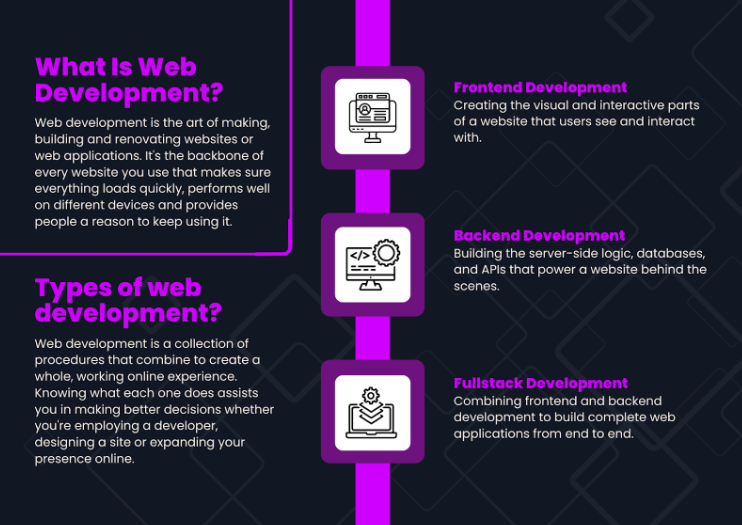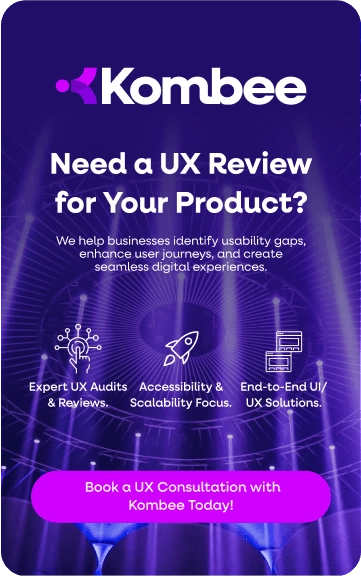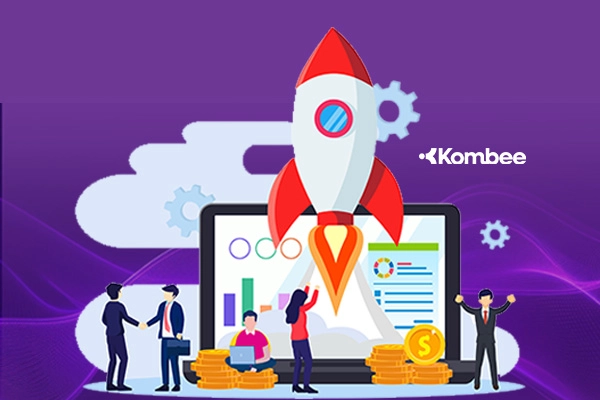Introduction
Are you aware why web development is important for business success in 2025? That didn't occur by chance. At the back of every seamless, secure and interactive website is a group of experts who are web developers.
With 200 million active websites globally, web development offers businesses a significant opportunity to stand out and reach a massive audience. By building a strong, functional website, you tap into the growing digital market, connect with millions of potential customers and drive growth for your business in 2025.
Therefore, let's understand what is web development, why it's important and how it can change your business.
What Is Web Development?
Web development is the art of making, building and renovating websites or web applications. It's the backbone of every website you use that makes sure everything loads quickly, performs well on different devices and provides people a reason to keep using it.
For companies, website development for business means more than just having a homepage. It entails secure payment gateways, interactive product pages, analytics portals and custom client portals.
Types of Web Development

Web development is a collection of procedures that combine to create a whole, working online experience.
Knowing what each one does assists you in making better decisions whether you're employing a developer, designing a site or expanding your presence online.
1. Frontend Development
Frontend development includes what users see and interact with like layout, buttons, images, navigation and forms. It uses tools like HTML, CSS, TypeScript, JavaScript and newer libraries like React or Vue to develop a smooth and responsive experience.
Why it matters:
- It's your brand's first impression to users.
- A fast, clean, mobile-responsive design inspires trust and engagement.
- Good frontend enables accessibility, making your site usable by all.
2. Backend Development
Backend development drives all the happenings behind the scenes such as data storage, logins, payments and so on. It's developed using languages such as Node.js, Python or PHP and utilizes databases such as MySQL, PostgreSQL or MongoDB.
Why it matters:
- Secures your site, particularly with customer information and transactions.
- Sustains important functions such as search, user accounts and shopping carts.
- Scales using cloud platforms such as AWS or Firebase.
3. Full-Stack Development
Full-stack includes both frontend and backend. A full-stack developer does it all from interface design to server logic and commonly deploys the site using Vercel and other platforms.
Why it matters:
- Perfect for small to mid-size companies with compact, cost-efficient solutions needed.
- Eliminates slowness by having one person or team do the whole project.
- Ideal for creating full sites or MVPs fast and efficiently.
Case Study: One of our recent successes was developing a powerful Shopify store for Luxury Vault. The site features an enhanced product display, secure payments, mobile usability, and integrated customer analytics—helping them offer a seamless online shopping experience and drive higher conversion rates.
Web Design vs. Web Development
It's not unusual to hear these two words being used interchangeably but web development and web design are distinct activities. Both are critical components of launching a successful site but they do very different things.
Web Design vs. Web Development
| Feature | Web Design | Web Design Web Development |
|---|---|---|
| Primary Focus | Visual aesthetic and user experience (UX/UI) | Functionality, framework and performance |
| Key Goal | Make the site look nice and be easy to navigate | Make the site function on devices and platforms |
| Involves Coding? | Typically no (but might use low-code technology) | Yes, complete coding for both frontend and backend |
| User Interaction Role | Makes design of how users should interact | Constructs how users actually interact |
The actual power comes from how both come together:
- Design brings users in
- Development makes experience function
When web development and web design complement each other, your business receives a website that's not only aesthetically beautiful but also works, is quick and effective at converting visitors into customers.
The AI Role in Web Development
AI is no longer a trend, it's now a part of smart, efficient web development. It's not stealing developers' jobs, but helping them work faster, provide better results and create more cognitive websites that directly contribute to business expansion.
Here's how the web development process is being revolutionized by AI and why it should interest your company:
- Rapid Development: Programming assistants such as GitHub Copilot or Tabnine utilizing AI, assist developers in coding clean, concise code in a matter of minutes. This reduces development periods as well as saves labor expenses and has your website up sooner without sacrificing quality.
- Smarter Customer Support: AI chatbots can now handle anything from basic FAQs to more complex issues. They work 24/7 by giving immediate feedback and liberating your support staff while improving the customer experience on your site.
- Personalized User Experiences: AI interprets actual user behavior like clicks, time on page or past purchases and adjusts what every visitor sees. That can mean personalized product recommendations or maybe dynamic content or specific pop-ups all which generate more conversions and keep people around longer.
- Better Testing & Quality Assurance: AI technology is able to run automated tests on devices and browsers as well as detect bugs before they happen and even predict probable points of failure. The result is fewer issues after release as well as smoother user experiences and lower long-term maintenance costs.
Stages of Web Development for Business Projects
Starting a high-performing website requires adhering to a specific process. These are the five fundamental steps every company needs to undertake:
- Requirement Gathering: Establish your objectives. What should your website accomplish to generate leads, sell goods, serve customers? This phase gets your site's features in sync with your business strategy and customer requirements. You can contact us to help you with the entire process.
- Wireframing and Design: Designers draw out page layouts and outline the user experience. With tools such as Figma, they lay out how users will interact with and move through your site before coding ever takes place.
- Development: Developers construct the actual site, frontend (what users interact with) and backend (how it functions). They make it responsive, fast and integrated with any required systems such as databases or payment gateways.
- Testing and Optimization: All is tested: speed, security, mobile-friendliness and functionality. SEO fundamentals are also configured so your website is optimized for both visitors and search engines.
- Deployment and Feedback Loop: The site is live! But successful companies don't leave it there, they gather feedback, monitor user behavior with analytics and keep optimizing the site for improved performance.
Key Web Development Skills and Tools in 2025
When hiring a web developer in 2025 whether for a new website, a web app or an upgrade, look for these core skills and tools. They ensure the final product is fast, secure, scalable and built for business results:
Strategic Thinking
With 81% of U.S. consumers researching products online before buying, strategic thinking in web development plays a critical role in business growth. A strong developer aligns site features with goals like lead generation and user engagement to maximize conversions.
Modern Development Tools
By mid-2025, 2.5% of websites were created using only AI, showing a shift toward automation in web development. To stay relevant, developers must master tools like React, Next.js, Node.js, and Django. Next.js pairs well with AI to boost SEO and speed and Node.js to support scalable, efficient backends.
Database Experience
With e-commerce and data-driven apps growing, securely handling sensitive data is a top priority for US businesses. Developers should be experienced with PostgreSQL for structured data or MongoDB for flexible and scalable storage. GraphQL is also key for efficient, flexible data queries.
Cloud & Deployment Knowledge
With cloud platforms like AWS, Vercel, and Netlify developers can deploy and scale your website efficiently. Proficiency in CI/CD pipelines and automated testing ensures smooth and error-free deployments.
Security Best Practices
Security is a top priority, especially since 20% of websites face vulnerabilities during development. Developers should implement HTTPS and JWT/OAuth for authentication and follow OWASP guidelines to protect against common threats like SQL injections and XSS.
Efficiency Tools
Developers should use tools like Git for version control and automated testing like Jest, Cypress to maintain quality and speed up development. Agile practices and tools like Jira keep projects on track.
Design Awareness
Developers need to understand responsive design principles to ensure websites work across devices. Knowledge of CSS Grid, Flexbox and Tailwind CSS is crucial for fast, scalable and attractive websites.
If you want to dive deeper into how design impacts user experience and retention, read our blog on how to boost user retention and daily active users with effective UI/UX design. It’s essential reading for anyone looking to improve their site’s user engagement and success.
Selecting the Right Web Development Team or Partner
Your site isn't merely digital property, it's your brand's initial impression and your best sales investment. Here's what to seek out when selecting a partner to construct it correctly:
1. Strategic Vision of Your Business
Top developers don't merely code; they pose wise questions, pay close attention and make your website align with your true business objectives. That is precisely how Kombee operates like an expansion of your internal team.
2. Proven SEO and Visibility Expertise
A good-looking website won’t help if no one can find it. Kombee integrates technical SEO and speed optimization right from the start ensuring your site performs in search, not just in design.
3. Built-In Security from Day One
With rising cyber threats, your website must be secure. Kombee uses best-in-class security practices, including HTTPS, firewall protection and regular audits protecting both your business and your users.
4. Personalized Design That Reflects Your Brand
Templates are not enough. Your business needs a personalized look and feel. Kombee designs custom builds that set your business apart and look great on every device.
5. A Transparent, Trustworthy Development Process
From launch to launch, you need a team that listens clearly and follows through on deadlines. Kombee employs a tested, transparent process so you always know what's happening and when.
6. Long-Term Growth and Support Emphasis
A website isn't complete at launch. Kombee provides ongoing support, performance analysis and active updates to ensure your site grows with your business.
Looking for a trusted partner to bring your vision to life? Kombee offers web development services that businesses can trust. From frontend aesthetics to secure backend infrastructure, our team ensures your site is designed for performance, security and scalability helping your business grow in the digital age.
Conclusion
In 2025 your site isn't just an online property but a key business driver. Whether you're selling goods, providing services or releasing software, smart web development can fuel profits as well as improve customer experience and future-proof your expansion. From frontend aesthetics to secure backend infrastructure, AI integration and SEO optimization, the correct approach yields long-term results.
Is your website simply online or truly driving outcomes? Working with a team such as Kombee guarantees your site is developed for performance, security and scalability in the modern digital age.
Frequently Asked Questions
1. When should a business invest in custom web development?
A business should invest in custom web development when it needs unique features, scalability, or a tailored solution that standard templates can’t provide. It's ideal for businesses seeking a distinctive brand identity or complex functionality.
2. What’s the ROI of modern web development in 2025?
The ROI of modern web development in 2025 includes improved user experience, increased conversions, enhanced brand credibility, and better customer engagement. A well-designed website can boost sales, streamline operations, and provide long-term growth opportunities.
3. How long does it take to develop a custom business website?
The timeline varies, but typically, custom business website development takes 6 to 12 weeks, depending on complexity, features, and design requirements. Larger, more intricate sites may take longer due to additional customizations and testing.
4. How often should I update or redesign my business website?
It’s recommended to update your website at least once every 1–2 years. Redesign it when your branding, goals, or technology needs a major shift, or if performance, user experience, or SEO becomes outdated. Regular updates ensure functionality and relevancy.







